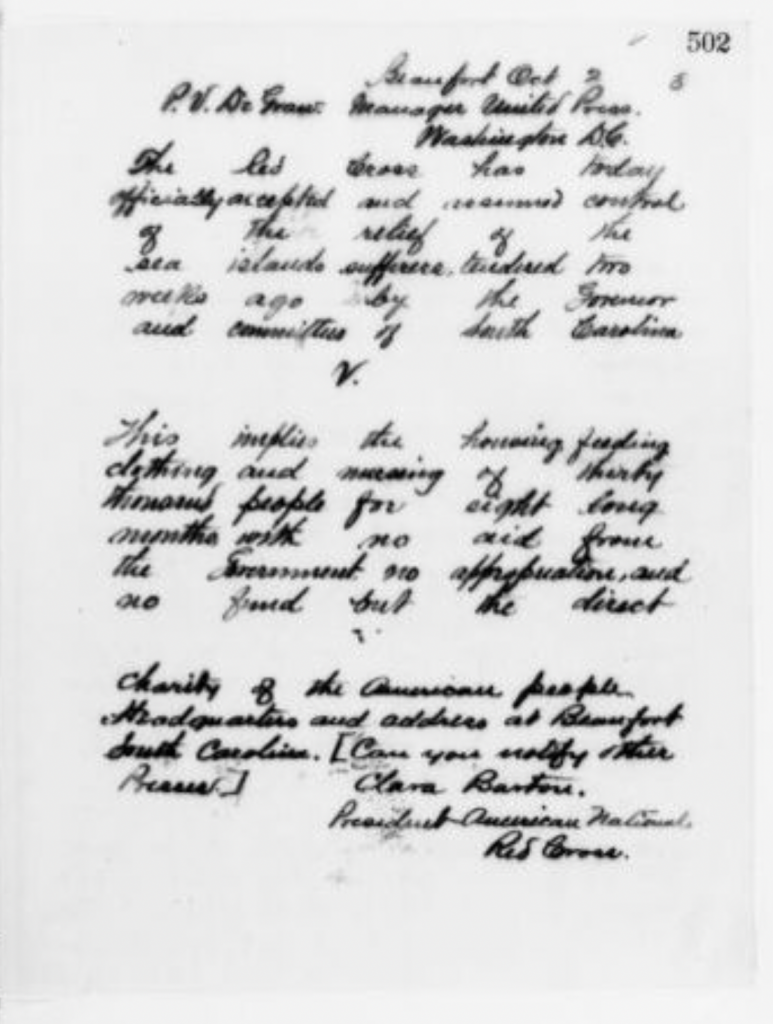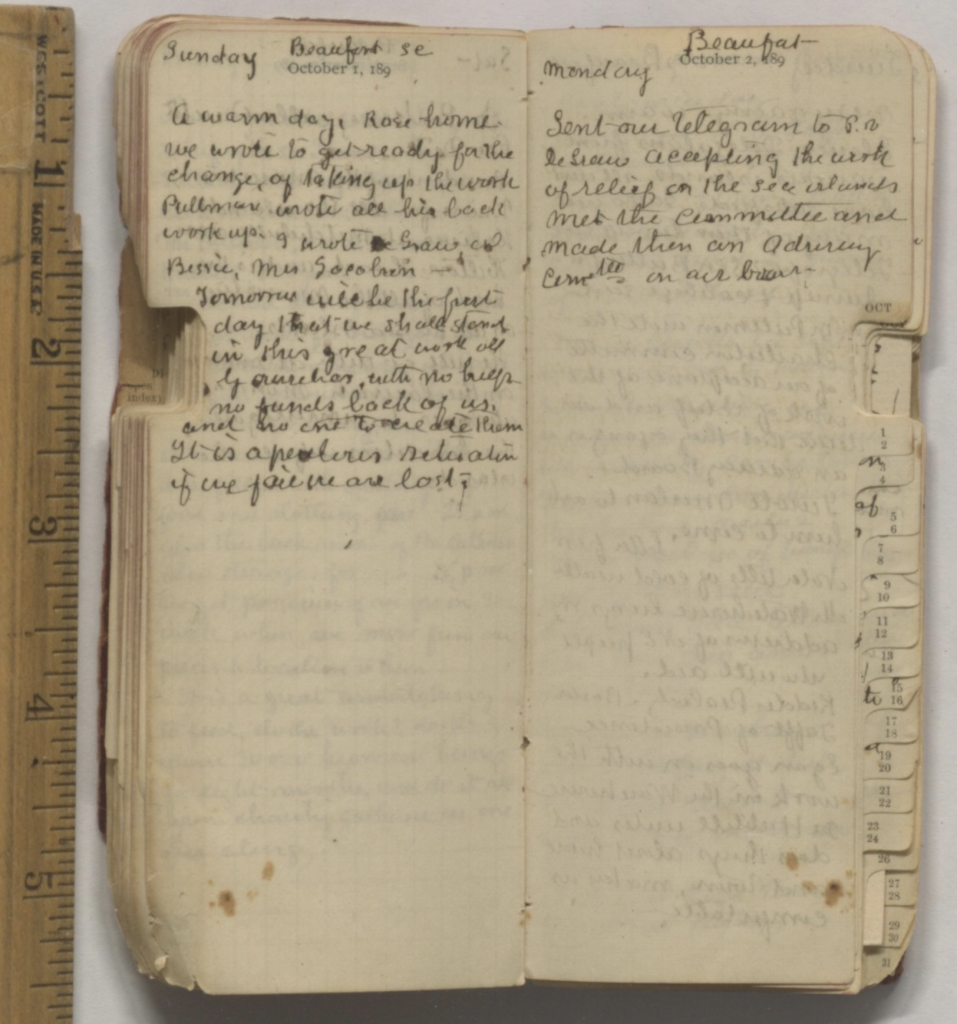One of the Library’s crowdsourcing projects at By The People is “Clara Barton: ‘Angel of the Battlefield,’” in which volunteers are transcribing the diaries of the legendary nurse.
Michelle Krowl, a historian in the Library’s Manuscript Division, recently was working with Barton’s diaries, puzzling over a blurred name. For those of you drawn to such literary mysteries, and who might be intrigued to try your hand on the project, here’s a story of her detective work. Share your By the People stories with us, too!
I recently delved into Clara Barton’s diaries and stumbled across the kind of puzzle that makes my work so fascinating. My story might help you, as a kind of a how-to, in using the Library’s resources in your own research.
It began when I was looking into Elizabeth Brown Pryor’s biography, Clara Barton: Professional Angel. The task at hand was to determine if Pryor used Barton’s diaries to help document Barton’s work following the Sea Islands Hurricane of Aug. 27, 1893, which devastated South Carolina. Yes, it turned out: Pryor cited several dates, and quoted from Barton’s diary entry of October 1, 1893.
Here is that page, from Barton’s May 1893-May 1894 pocket diary. It is tiny, just 5.5 inches tall.
On the project site, I noticed a volunteer had completed most of that Oct. 1 entry, and correctly added brackets for words that were illegible or speculative. Since several brackets overlapped the quotation supplied by Pryor in her book, I added the missing words to the transcription.
Then curiosity took hold. I looked at the other doubtful words. At least one was a name, which the original transcriber reasonably speculated was “Grace.”

On the next page, though, in a sentence that reads, “Sent our telegram to…” the same name now looked more like “De G—-.”

I was intrigued. I wanted to make that identification. But how could I find the name?
First, I turned to the Clara Barton Papers, available online through the Manuscript Division. I looked in the General Correspondence series, which is arranged alphabetically by the name of the correspondent. Scanning the “D” names in the collection finding aid, I got a hit: “DeGraw, Peter V.”

Ideally, for confirmation, in the “DeGraw, Peter V. and Emma” file, I would find a letter to Barton beginning, “I received your telegram of October 2….” That would have sealed the deal. Alas, this was a dead end. There was no such letter.
Still, I kept looking, and I discovered something nearly as good. Years earlier, in 1888, DeGraw had written a letter to Barton. On the back of it, Barton noted, “P. V. DeGraw,” in script that looked convincingly similar to her later diary entry.

That was good, but not quite proof positive.
So, next, I went back to the Barton Papers. I consulted the Letterbook series, which contains copies of letters and memoranda, written by Barton and other Red Cross officials. It is arranged chronologically.
The June 1892-January 1894 volume was promising. An index at the front listed the page numbers of DeGraw correspondence, helping me hone in quickly. And there, on page 502, the mystery was solved. A copy of an Oct. 2, 1893 telegram sent by Barton to “P. V. DeGraw,” notified him that the Red Cross accepted responsibility for Sea Islands relief work.

Telegram from Barton to P. V. DeGraw, October 2, 1893
The telegram includes Barton’s prediction that the work would involve meeting the needs of “thirty thousand people for eight long months with no aid from the Government,” which later accounts suggest was not far from the reality.
That was it. I had my mystery solved. I added in the name to the transcript, delighted.
I was not quite done, though. Barton’s own writings helped interpret another mysterious word in brackets… the final word on October 2:

The transcriber recorded the last two words as “all [ ].” Could I solve that, too?
Barton, I knew, published books on her life and the work of the American Red Cross, so I again consulted the Barton Papers online. First, I went to the Related Resources page, and looked under the “selected Barton publications” list. The Sea Islands relief work comprises an entire chapter in “The Red Cross in Peace and War.” Reading that, I noticed that a passage on page 202 suggested a possible interpretation: “…the Beaufort Relief Commission, as appointed by the governor, was formally released as a committee and immediate re-elected by the Red Cross as its ‘advisory board’….”
Could “all [ ]” actually be “our board.” hurriedly written in a small pocket diary? I think so, but the reviewer of my addition to the transcription will be the judge.
So, to sum up: Through the efforts of previous transcribers, my consultations of the collection finding aid and the Barton Papers, plus Barton’s own writings, the diary entries for October 1-2, 1893, may now be complete.
This might seem like a considerable effort for a short text. But I hope that this example of using numerous parts of the Barton collection to solve its mysteries might help other transcribers understand the context in which Barton wrote about her relief work, and offer ideas about how to track down the people and groups who were part of her universe.
Plus, who are we kidding? The detective work is fun!
Subscribe — it’s free! — and the largest library in world history will send one cool story to your inbox Monday-Friday.

















